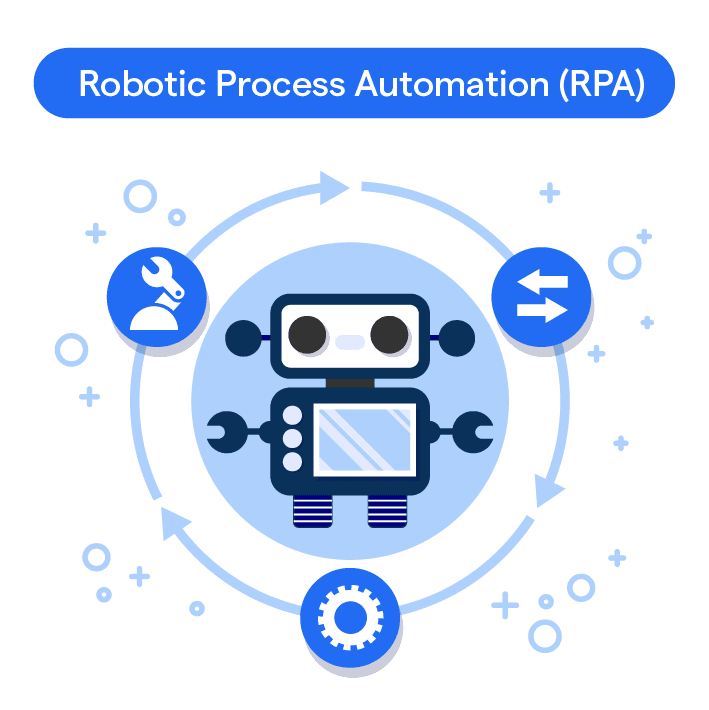The Magic of RPA: How It Works to Boost Your Business
The Magic of RPA: How It Works to Boost Your Business
Introduction to RPA:
In an era where business efficiency and automation are at the forefront of innovation, understanding how RPA works is crucial for organizations looking to stay ahead. Robotic Process Automation (RPA) offers the magic touch to streamline operations, reduce costs, and enhance productivity. By mimicking human actions to perform repetitive tasks, RPA is transforming the way businesses operate. This transformative technology not only supports but accelerates the digital transformation journey, making it an essential asset for companies across various industries.
This article delves into the mechanisms of RPA, shedding light on robotic process automation examples and the notable benefits it brings to the business landscape. Readers will gain insights into the practical applications of RPA across different business functions, highlighting the versatility and efficiency of this technology. Furthermore, the piece will explore effective strategies and best practices for implementing RPR, drawing from the expertise of leading RPA companies. With a clear understanding of how RPA works, businesses can unlock the full potential of this revolutionary technology, propelling them toward unparalleled growth and success.
Understanding RPA and Its Mechanisms
Robotic Process Automation (RPA) is a technology that automates routine tasks by mimicking human interactions with digital systems. It uses software robots, or “bots”, to execute predefined tasks on a computer. These bots can log into applications, enter data, calculate and complete tasks, and then log out.
What is RPA?
RPA integrates the use of software with artificial intelligence (AI) and machine learning capabilities to handle high-volume, repeatable tasks that previously required human execution. This technology is especially useful in industries where tasks are consistent and data-intensive.
How RPA Works: Basic Components
The basic components of RPA include the RPA bots themselves, a control dashboard to manage these bots, and the underlying analytics systems that monitor and optimize bot performance. Bots work by following programmed rules and interacting with systems through a user interface, without altering the underlying systems.
RPA in Action: Real-World Examples
In practice, RPA can automate tasks such as processing transactions, maintaining records, and responding to queries. For example, in the banking sector, RPA bots can automate the process of data entry and validation for loan processing, significantly reducing the time and resources spent on these tasks.
Key Benefits of Implementing RPA in Business
Robotic Process Automation (RPA) significantly enhances operational efficiency by automating repetitive and time-consuming tasks, allowing employees to focus on more strategic activities. This shift not only boosts productivity but also increases job satisfaction as employees engage in more meaningful work [21].
Enhancing Efficiency and Productivity
RPA accelerates process cycle times as bots complete tasks much faster than humans, reducing overall turnaround time for critical processes. This increased speed and efficiency contribute to cost reduction, as time-consuming activities are completed in a fraction of the time [20].
Reducing Operational Costs
Implementing RPA can lead to substantial cost savings by automating routine processes, thereby reducing labor costs and minimizing expenses related to errors and optimized resource allocation. Some businesses report a return on investment within a few months of implementation [21]. Additionally, RPA allows organizations to optimize their workforce by reducing the need for additional human resources, leading to significant long-term cost savings [20].
Improving Accuracy and Compliance
RPA enhances data accuracy and quality by eliminating errors associated with manual data processing, supporting better decision-making and operational efficiency. Automated compliance-related tasks ensure consistent adherence to regulations, reducing the risk of non-compliance and manual oversight [20][21]. Furthermore, RPA streamlines the audit process by automating data collection and reporting, minimizing the need for manual data gathering and reducing audit costs [20].
RPA Use Cases Across Various Business Functions
RPA in Customer Service
Robotic Process Automation enhances customer service by automating routine tasks such as handling inquiries and updating records, thus freeing up agents to focus on more complex issues [25][26][27]. Automated bots can manage customer interactions 24/7, improving response times and overall customer satisfaction [25].
RPA in Finance and Accounting
In finance and accounting, RPA streamlines processes like invoice processing and financial reporting, reducing errors and improving efficiency [28][29][30]. Automation in this sector helps in managing detailed and repetitive tasks, ensuring accuracy and compliance with financial regulations [29][30].
RPA in Human Resources
RPA significantly improves efficiency in HR by automating tasks from recruitment to payroll management [31][32][33]. This automation supports HR departments in managing large volumes of administrative work more effectively, enhancing overall operational efficiency [31][32].
RPA in Supply Chain and Logistics
In the supply chain and logistics sector, RPA optimizes operations from inventory management to order processing and delivery [34][35]. Automation facilitates better management of order updates and customer notifications, enhancing the overall efficiency of the supply chain [34][35].
Implementing RPA: Strategies and Best Practices
Steps to Implement RPA in Your Organization
To initiate RPA, assess processes suitable for automation, focusing on cost-savings and efficiency gains [37]. Select an RPA vendor through a rigorous process that includes technical demonstrations and evaluations [37]. Implement the RPA solution, ensuring alignment with business objectives and integration with existing systems, followed by detailed testing and optimization [37].
Overcoming Common Challenges in RPA Adoption
Address technical challenges by ensuring compatibility with existing software and robust IT infrastructure [40]. Tackle business challenges by aligning RPA implementation with clear business objectives and engaging stakeholders [41]. Navigate regulatory challenges by ensuring compliance and data security, particularly in sensitive sectors [40].
Future Trends and Innovations in RPA
RPA is evolving towards integrating AI and ML, enhancing its capability to handle complex tasks and decision-making processes [45]. The development of Intelligent Process Automation (IPA) and Process Mining are significant trends, enabling more strategic and efficient automation [45]. Additionally, the rise of RPA-as-a-service models is making the technology more accessible to a broader range of businesses [45].
Conclusion
Throughout this exploration of Robotic Process Automation (RPA), we’ve illuminated how it acts as a keystone in modern business strategy, driving efficiencies, and innovation across various sectors. The comprehensive overview spanning from its mechanisms, benefits, practical applications, and best practices, underlines the transformative potential of RPA. By automating repetitive tasks, this technology not only streamlines operations but also propels businesses towards achieving unprecedented accuracy, cost savings, and operational excellence. The integration of RPA within the fabric of organizational processes signifies a leap towards embracing digital transformation, reinforcing the critical role it plays in fostering a competitive edge in today’s fast-paced business environment.
Looking ahead, as businesses continue to navigate the intricacies of digital transformation, the adoption and sophistication of RPA will undoubtedly escalate. This journey, underscored by our discussions on implementing RPA and overcoming associated challenges, opens avenues for further innovation and efficiency within industries.
In light of the emerging trends towards integrating AI and machine learning with RPA, the future promises even greater automation capabilities. Therefore, embracing RPA not only serves as a catalyst for immediate operational improvement but also paves the way for harnessing future technological advancements. As we conclude, the pivotal role of RPA in shaping the future of business becomes ever more apparent, underscoring its significance as an indispensable tool in the quest for efficiency, innovation, and growth.
FAQs
How does RPA contribute to the success of my business?
RPA, or Robotic Process Automation, offers a wide array of advantages that can significantly boost your business’s success. These advantages include a reduction in staffing costs due to automation, elimination of human errors, an increase in the capacity to handle larger volumes of work, enhanced customer service and customer experience (CX), along with higher productivity and return on investment (ROI).

Can you provide a prime example of RPA’s role in enhancing business operations?
A prime example of RPA’s impact on business processes is its ability to replace manual, error-prone tasks with automated solutions. This not only reduces the likelihood of errors but also speeds up operations and lowers costs. By assigning routine, low-value tasks to RPA bots, businesses can significantly improve efficiency, freeing up human employees to focus on tasks that require human intelligence and creativity. This shift leads to an overall increase in productivity.
In what ways does RPA lead to an increase in revenue?
RPA contributes to revenue growth mainly through the automation of billing processes. By implementing automated billing systems, businesses can ensure greater accuracy and minimize delays in payments. This has a direct positive effect on the revenue cycle, leading to an increase in earnings.
What impact does RPA have on business operations?
RPA significantly improves operational efficiency and accuracy by automating manual and repetitive tasks. Robots programmed with RPA can operate 24/7 without breaks, ensuring tasks are completed both promptly and accurately. This not only leads to cost savings but also enhances service delivery and supports better decision-making across the business.
5. Integration with Customer Relationship Management (CRM) Systems
In today’s competitive business landscape, customer relationship management (CRM) systems play a crucial role in helping businesses understand their customers better and build stronger relationships with them. Integrating software solutions with CRM systems is essential for better customer management and improved overall customer experience.
Importance of Integration:
Integrating software solutions with CRM systems allows businesses to centralize customer data, interactions, and feedback. This integration provides a comprehensive view of each customer, including their purchase history, preferences, and previous interactions with the company. By having all this information in one place, businesses can personalize their interactions with customers, anticipate their needs, and provide more tailored and targeted services.
Moreover, integrating software solutions with CRM systems enables businesses to automate various customer-related processes, such as lead management, sales forecasting, and customer support. This automation not only increases efficiency but also ensures consistency in customer interactions across different touchpoints.
Strategies for Seamless Integration:
To ensure seamless integration with CRM systems, businesses should prioritize compatibility and interoperability when selecting software solutions. The chosen software should have built-in integration capabilities or provide easy-to-use APIs for connecting with CRM systems.
Additionally, businesses should define clear objectives and requirements for the integration process. This includes identifying the specific data points and workflows that need to be integrated between the software solution and the CRM system. Having a clear roadmap and project plan helps streamline the integration process and ensures that it meets the business’s needs and objectives.
Furthermore, businesses should provide adequate training and support to their employees to effectively utilize the integrated software solutions. Training employees on how to access and leverage customer data from the CRM system through the integrated software ensures that they can make informed decisions and provide better service to customers.

In summary, integrating software solutions with CRM systems is crucial for better customer management and enhanced overall customer experience. By following these strategies for seamless integration, businesses can leverage the power of CRM data to personalize interactions, automate processes, and improve customer satisfaction and loyalty.
6. Continuous Improvement and Feedback Loop
In the dynamic landscape of customer experience, the importance of gathering feedback and making continuous improvements to software solutions cannot be overstated. Customer needs and preferences evolve rapidly, making it essential for businesses to stay agile and responsive. Here’s why implementing a feedback loop and making iterative improvements is crucial for IT success:
Importance of Gathering Feedback:
Gathering feedback directly from customers provides invaluable insights into their experiences with your software solutions. Whether it’s identifying pain points, understanding feature requests, or simply gauging overall satisfaction, customer feedback serves as a compass for improvement. By actively seeking and listening to customer feedback, businesses can identify areas for enhancement and prioritize development efforts effectively.
Continuous Improvement:
Continuous improvement is not a one-time endeavor but a mindset that needs to be ingrained within the organization. Software solutions should be treated as living entities that evolve with the changing needs of customers. Regular updates and enhancements ensure that the software remains relevant, efficient, and aligned with the organization’s goals.
Strategies for Implementing a Feedback Loop:
Implementing a feedback loop involves creating channels for customers to provide feedback easily and ensuring that this feedback is acted upon. This can include:
- Surveys and Questionnaires: Sending out regular surveys to gather feedback on various aspects of the software.
- User Testing and Beta Programs: Involving customers in the testing phase of new features or updates to gather real-time feedback.
- Monitoring Support Channels: Analyzing customer support interactions to identify recurring issues or pain points.
- Social Media Listening: Monitoring social media channels for mentions, comments, and feedback about the software.
Making Iterative Improvements:
Once feedback is collected, it’s essential to act upon it promptly. Prioritize feedback based on its impact and feasibility, and implement changes in iterative cycles. This ensures that improvements are made steadily, without disrupting the user experience or overburdening development teams.
By establishing a robust feedback loop and making iterative improvements, businesses can ensure that their software solutions remain responsive, relevant, and aligned with customer needs and expectations.
7. Scalability and Flexibility
In today’s rapidly evolving digital landscape, customer needs and preferences can change overnight. To effectively cater to these changing demands, it’s crucial for businesses to invest in scalable and flexible software solutions.
Importance of Scalable and Flexible Software Solutions:
Scalability and flexibility are essential characteristics of software solutions that enable businesses to adapt to the evolving needs of their customers. Scalable software can handle increasing amounts of work or traffic without compromising performance. Similarly, flexible software can be easily modified or customized to accommodate changes in customer requirements or business objectives.
With scalable and flexible software solutions in place, businesses can:
- Handle Growth: As businesses expand and attract more customers, their software systems need to be able to handle increased workloads and user demands. Scalable software ensures that businesses can seamlessly accommodate growth without experiencing downtime or performance issues.
- Respond to Market Changes: Market trends and customer preferences are constantly changing. Flexible software solutions enable businesses to quickly adapt to these changes by modifying features, adding new functionalities, or making other adjustments as needed.
- Improve Customer Satisfaction: By ensuring that software systems can scale and adapt to changing customer needs, businesses can deliver a better customer experience. Whether it’s adding new features based on customer feedback or quickly resolving issues, scalable and flexible software solutions play a vital role in enhancing customer satisfaction.
Strategies for Ensuring Scalability and Flexibility:
To ensure that software solutions are scalable and flexible, businesses can:
- Use Cloud-based Solutions: Cloud computing provides a scalable infrastructure that can easily accommodate changes in demand. By leveraging cloud-based solutions, businesses can scale their software systems up or down as needed.
- Implement Modular Architecture: Breaking down software systems into smaller, modular components makes it easier to scale and modify individual parts of the system without affecting the entire application.
- Continuous Monitoring and Optimization: Regularly monitoring software performance and user feedback allows businesses to identify areas for improvement and make necessary adjustments to ensure scalability and flexibility.
By prioritizing scalability and flexibility in their software solutions, businesses can effectively adapt to changing customer needs and maintain a competitive edge in the market.
Conclusion
In today’s competitive digital landscape, providing an exceptional customer experience is paramount for businesses to succeed. Software solutions play a crucial role in enhancing customer experience, and here are seven key strategies to leverage them effectively:
- Personalization and Customization: Tailoring experiences to individual customer preferences enhances engagement and builds brand loyalty. Utilize software solutions to collect and analyze customer data, enabling personalized interactions across various touchpoints.
- Omni-channel Integration: Customers expect a seamless experience across all channels. Integrating software solutions to ensure consistency and continuity across channels—whether it’s online, in-store, or through mobile devices—is essential for meeting these expectations.
- Data-driven Insights: Leveraging customer data allows businesses to gain valuable insights into customer behavior and preferences. Implement software solutions to collect, analyze, and utilize data effectively, enabling data-driven decision-making and personalized customer interactions.
- Automation and Efficiency: Automation streamlines processes, reduces manual tasks, and enhances efficiency. Implement software solutions to automate repetitive tasks, freeing up time for your team to focus on providing exceptional customer service and experience.
- Integration with Customer Relationship Management (CRM) Systems: Integrating software solutions with CRM systems enables businesses to manage customer interactions more effectively. Utilize CRM software to centralize customer data, track interactions, and personalize communication for improved customer satisfaction.
- Continuous Improvement and Feedback Loop: Gathering customer feedback and making iterative improvements is key to enhancing the customer experience. Implement software solutions to gather feedback, analyze data, and make informed decisions to continuously improve your products and services.
- Scalability and Flexibility: Scalable and flexible software solutions are essential for adapting to changing customer needs and business requirements. Invest in software solutions that can grow with your business and easily adapt to evolving customer expectations.
Emphasis on the Importance of IT Success:
Successfully implementing these strategies requires a robust IT infrastructure and effective utilization of software solutions. By prioritizing IT success, businesses can significantly improve overall customer satisfaction and loyalty. Investing in the right software solutions and IT strategies not only enhances the customer experience but also drives business growth and success in today’s digital age.


